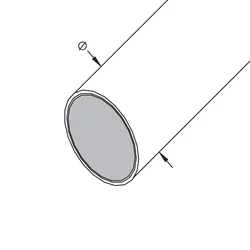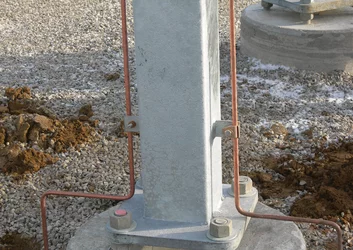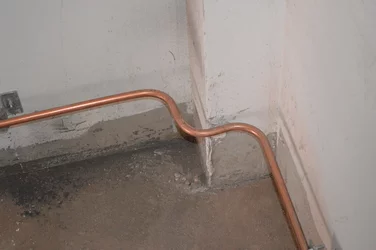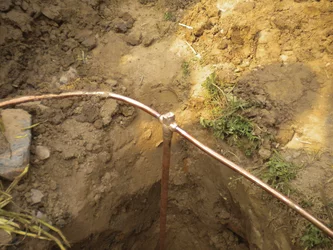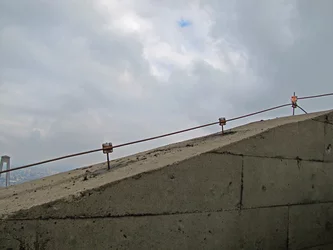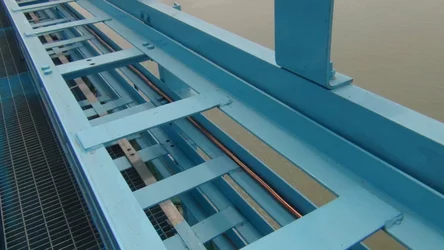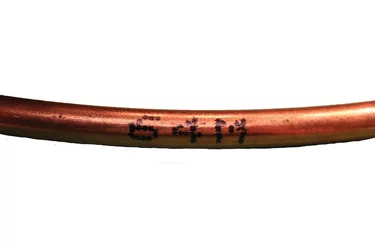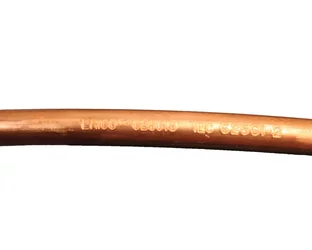 Zum Vergrößern über das Bild fahren oder klicken
Zum Vergrößern über das Bild fahren oder klicken

nVent ERICO Cu-Bond Round Conductor
For decades, nVent ERICO has provided the market with high quality copper-bonded ground rods. nVent ERICO has taken that same concept in ground rods and made this into a revolutionary new grounding conductor. The core of the nVent ERICO Cu-Bond Round Conductor is a low carbon steel grade for improved flexibility in the field. The steel core is plated with nickel then electro-plated with a coating of copper. This electro-plating process helps ensure a long-lasting molecular bond between the copper layer and the steel.
The steel core of the conductor provides theft-deterrent benefits, making the conductor difficult to cut with hand tools. With this steel core, nVent ERICO Cu-Bond Round Conductor is a cost-effective alternative to 100% copper conductor. The copper surface of the conductor provides high conductivity and corrosion resistance properties.
Above grade, the unique properties of nVent ERICO Cu-Bond Round Conductor make it ideal for both horizontal and vertical placement. The conductor is well-suited as a lightning protection conductor when applied in accordance with the IEC 62305-3 Edition 2.0 standard.
In the utility industry, the product can be used as a distribution down-lead conductor or as part of a bonding kit for substation fences or equipment ground risers back to the grid. In telecom applications, the product can be used to connect an equipment ground to the ground grid, as a riser (down-lead) for towers, or as a grounding conductor for datacenter mesh bonding. They are also well suited for rail applications such as trackside bonding conductors and stray current conductors, grounding kits for trackside equipment, electrical traction power, as well as in substation, wayside shelters, and communication antenna equipment.
Below grade, nVent ERICO Cu-Bond Round Conductors are ideal as earthing and bonding conductors where copper theft may occur. They may be used as a buried ground grid conductor or electrode for wireless telecom towers, power distribution and transmission grounding in utility substations, large scale ground mount solar farms, petro-chemical and mining infrastructure in industrial facilities, and railway applications. The conductor also can be used as an interconnecting grounding conductor between wind towers or as a grounding grid at the base of a wind tower.
Merkmale
- Theft-deterrent; steel core is hard to cut with hand tools
- Cost-effective; copper bonded to a steel core minimizes the amount of copper in the cable
- Superior corrosion resistance; application life of typically 30-40 years in most soil conditions
- Copper-bonded coating will not crack or tear when the conductor is bent
- High resistance to corrosion and provides a low-resistance path to ground
- nVent ERICO Cu-Bond Round Conductor is marked every meter (3.28') for easy measurement in the field
- Meets the requirements of IEC® 62305-3 Edition 2 and IEC/EN 62561-2 for lightning protection applications
- nVent ERICO Cu-Bond Round Conductors are UL certified to IEC® 62561-2
Spezifikationen
| Leiter - Vergleich der physischen Größe | ||
| Kabelschutzleitergröße | Ungefährer Durchmesser | Querschnitt |
| 25 mm² | 6,76 mm | - |
| 35 mm² | 7,65 mm | - |
| CBSC8 | 8,00 mm | 50,27 mm² |
| 50 mm² | 8,89 mm | - |
| CBSC10 | 10,00 mm | 78,52 mm² |
| 70 mm² | 10,69 mm | - |
| 95 mm² | 12,47 mm | - |
| CBSC13 | 13,20 mm | 138,07 mm² |
| CBSC14 | 14,20 mm | 158,90 mm² |
| 120 mm² | 14,22 mm | - |
| CBSC16 | 15,70 mm | 199,84 mm² |
| 150 mm² | 15,75 mm | - |
| 185 mm² | 17,65 mm | - |
| CBSC18 | 17,70 mm | 243,27 mm² |
| Leitfähigkeitsvergleich | ||||
| Teilenummer | AWG (Ω/km) | CBSC Widerstand pro Längenvergleich | mm² (Ω/km) | CBSC Widerstand pro Längenvergleich |
| CBSC18 | 1/0 AWG | 118,52 % | 50 mm² | 110,82 % |
| 2 AWG | 74,54 % | 35 mm² | 77,57 % | |
| CBSC16 | 2 AWG | 102,20 % | 35 mm² | 106,36 % |
| 4 AWG | 64,27 % | 25 mm² | 75,97 % | |
| CBSC14 | 2 AWG | 137,78 % | 25 mm² | 102,42 % |
| 4 AWG | 86,65 % | 16 mm² | 65,55 % | |
| CBSC13 | 2 AWG | 134,46 % | 25 mm² | 99,95 % |
| 4 AWG | 84,56 % | 16 mm² | 63,97 % | |
| CBSC10 | 4 AWG | 132,25 % | 16 mm² | 100,05 % |
| 6 AWG | 83,17 % | 10 mm² | 62,53 % | |
| CBSC8 | 6 AWG | 107,85 % | 16 mm² | 129,73 % |
| 8 AWG | 67,83 % | 10 mm² | 81,08 % | |
| Schmelzstrom I rms (kA) - IEEE® 837 Anhang C | |||||||
| Leiterart Verkupfert, Stahlkern, Gewindestangea | CBSC8 | CBSC10 | CBSC13 | CBSC14 | CBSC16 | CBSC18 | |
| Leiterquerschnitt in mm2 | A | 50.265 | 78.52 | 138.07 | 158.903 | 199.84 | 243.27 |
| Anfängliche Leitertemperatur in °C | Ta | 40 | 40 | 40 | 40 | 40 | 40 |
| Zeit des Stromflusses in Sekunden | tc | 2 | 2 | 2 | 2 | 2 | 2 |
| Maximal zulässige Temperatur in °C | Tm | 1084 | 1084 | 1084 | 1084 | 1084 | 1084 |
| Wärmekoeffizient des spezifischen Widerstands bei Referenztemperatur Tr | ar | 0.00378 | 0.00378 | 0.00378 | 0.00378 | 0.00378 | 0.00378 |
| Widerstand des Erdleiters bei Referenztemperatur Tr in m und -cm | rr | 8.621 | 8.621 | 8.621 | 8.621 | 8.621 | 8.621 |
| 1 / a 0 oder (1 / a r) - Tr in ° C | K0 | 245 | 245 | 245 | 245 | 245 | 245 |
| Wärmekapazitätsfaktor in Joule / cm3/ ° C | TCAP | 3.846 | 3.846 | 3.846 | 3.846 | 3.846 | 3.846 |
| Leitfähigkeit des Materials | % | 24.5 | 20.4 | 18.8 | 15.9 | 16.3 | 17.7 |
| Sicherungsstrom-Berechnung | ß | 84.73 | 84.73 | 84.73 | 84.73 | 84.73 | 84.73 |
| I | 4.79 | 7.48 | 13.16 | 15.15 | 19.05 | 23.19 | |
| I90 % | 4.31 | 6.74 | 11.84 | 13.63 | 17.14 | 20.87 | |
| I80 % | 3.83 | 5.99 | 10.53 | 12.12 | 15.24 | 18.55 | |
Broschüre
Installationshandbuch/Kurzanleitung
Katalog
Zertifizierungen
- Warnung
- nVent-Produkte müssen in Übereinstimmung mit den Produktinformationsblättern und dem Schulungsmaterial von nVent installiert und verwendet werden. Informationsblätter sind verfügbar unter www.nVent.com sowie bei Ihrem nVent-Kundendienstvertreter. Unsachgemäße Installation, Missbrauch, Fehlanwendung oder andere Handlungen im Widerspruch zu den Anweisungen und Warnungen von nVent können zu Fehlfunktionen, Anlagenschäden, schwerer Körperverletzung sowie zum Tod führen und/oder haben die Annullierung der Garantie zur Folge.

